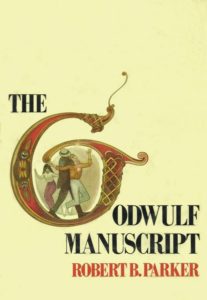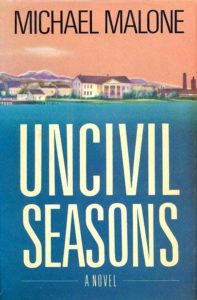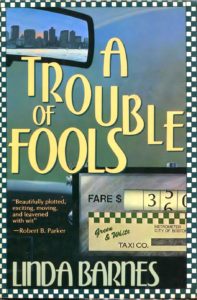Throughout much of the 20th century, American detective stories were set primarily in a mere handful of locales: New York City, Los Angeles, San Francisco, and to a lesser extent, Chicago and Miami.
As a result of escalating crime rates during Prohibition, post-World War II population shifts to the suburbs, and increasing poverty and violence in the inner cities, readers and authors alike were persuaded that the largest U.S. metropolitan areas—complex, contradictory, and prone to alienate their residents—offered natural venues for fictitious tales of bloodletting, political and police skullduggery, and underworld racketeering. So Sam Spade probed shootings and the thefts of bird statuettes in California’s Bay Area; Philip Marlowe practiced his sardonic remarks by the yearning glow of Hollywood searchlights; Thomas B. Dewey’s Mac chased suspects past Windy City landmarks; Michael Shayne braced thugs and embraced blondes in the shade of Miami Beach palms; and there was nary a corner of Manhattan left unscarred by Mike Hammer’s .45.
Some of this genre’s early contributors violated such restrictions. For instance, the action in Earl Derr Biggers’ introductory Charlie Chan mystery, The House Without a Key (1925), took place in Honolulu, Hawaii, where the “amiable Chinese” worked as a police detective. (Later Chan yarns often dispatched him to California.) In 1948’s Just Around the Coroner, by Stuart Brock (aka Louis Trimble), private investigator Peter Cory probed a rash of hotel robberies in Seattle. Robert Martin’s Jim Bennett (Dark Dream, 1951)—a happily married gumshoe amid a preponderance of lone wolves—headed up the Cleveland, Ohio, branch of a New York-based detective agency. Carney Wilde, concocted by Bart Spicer for The Dark Light (1949), went on to enjoy a flourishing P.I. career in Philadelphia. And certainly the most famous resident of Fort Lauderdale, Florida, was “salvage consultant” Travis McGee.
Even Dashiell Hammett’s cool-headed fireplug of a San Francisco snoop, the Continental Op, took to the boonies in Red Harvest (1929), when he was tasked with cleaning up a gang-bedeviled Montana mining town called Personville—or “Poisonville,” as the natives called it.
But again, those were exceptions. On the whole, crime-fiction enthusiasts seemed content with being served a more limited menu of story backdrops.
At least until the 1970s and ’80s. That’s when a restless new generation of detective-fictionists decided the field—grown stale after a mid-century deluge of male-oriented works formulated around cynical peepers, amorous female clients, and epidemic gunplay—needed a serious shaking-up in order to maintain relevance and readership. One result of that effort was a broader, updated perspective on what sorts of offenses could and should be addressed in these books: not just larceny, abductions, and choreographed slayings anymore, but also environmental injustices, endemic racism, human trafficking, right-wing extremism, domestic abuse, and child-custody disputes. Another way the genre diversified was by expanding its storytelling stage beyond familiar urban hubs, to rediscover the value of literary regionalism.
* * *
“The new regionalism,” wrote New York Times crime-fiction columnist Marilyn Stasio in 1987, “has tapped into the current and widespread belief that serious crime has spun out of control in the cities and that evil is now abroad in every hamlet in the land….This new strain of detective fiction makes no bones about its local roots; speaking in pungent native accents and pleased to tell a stranger all about the town history, these books wave their regional eccentricities like a flag.”
In 1973, when Parker’s first novel, The Godwulf Manuscript, saw print, Beantown was still terra incognita for most readers. Parker sought to change that.Among the earliest, most influential such banner bearers was Robert B. Parker. It’s a bit of a stretch to declare that his mono-monikered shamus, Spenser, put Boston, Massachusetts, on the mystery readers’ map; Jacques Futrelle’s master of logic, Professor Augustus S.F.X. Van Dusen (The Thinking Machine, 1907), Doris Miles Disney’s sharp-witted claims adjuster, Jeff DiMarco (Dark Road, 1946), and George Harmon Coxe’s resourceful photojournalist, Kent Murdock (Focus on Murder, 1954), had all made that burg home turf before Spenser. Yet in 1973, when Parker’s first novel, The Godwulf Manuscript, saw print, Beantown was still terra incognita for most readers. Parker sought to change that.
In more than three dozen yarns, until his death in 2010, the writer sent Spenser—wise-cracking ex-cop, quondam heavyweight boxer, gourmet cook, and chronic poetry quoter—on wide-ranging excursions across New England’s most populous city, visiting sites such as Faneuil Hall Market, Fenway Park, the ivied academic environs of Cambridge, the classic eatery Locke-Ober, and the Back Bay neighborhood, where the sleuth lived in a Marlborough Street brownstone, around the corner from Boston’s Public Garden. Parker spent most of his life in the Boston area, and his appreciation for the place was overt. Take the example of this extract from Godwulf, a story about Spenser’s search for a filched 14th-century illuminated manuscript, in which our hero admires the passing scenery even as he flees a local cult with a woman he’s just rescued:
We went down along the Charles on Memorial Drive and across the Mass Ave bridge. Boston always looks great from there. Especially at night, with the lights and the skyline against the starry sky and the sweep of the river in a graceful curve down toward the harbor.
Parker anchoring his stories in Boston wasn’t the only thing that separated them from the competition, explains Kevin Burton Smith, editor of The Thrilling Detective Web Site, a resource for private-eye-fiction fans. “He also introduced a genuine, ongoing sexual relationship between two compatible and equal adults”—Spenser and his longtime girlfriend, psychologist Susan Silverman—“and added race to the mix in a way that suggested two adults of different races could be equal partners in a friendship and not act like morons or picket signs.” It was in Parker’s fourth book, Promised Land (1976), a story involving kidnapping, loansharking, and radical feminists, that he welcomed another series regular, Hawk, Spenser’s tall, bald, brawny, proudly black, and persistently well-armed sidekick.
But the fact that “Boston was different than the typical P.I.-novel city possibly was a plus,” says Elizabeth Foxwell, who (with Dean James) wrote 2005’s The Robert B. Parker Companion. “I think one of Parker’s strongest novels is Promised Land, in which the Cape Cod setting is absolutely essential to the story. So it could be that the popularity of the Spenser novels made publishers more receptive to P.I. novels set in locations beyond New York and California.”
Or as Smith puts it, “I don’t know for sure if Parker and Spenser were responsible for the burgeoning [of regional crime fiction], but I’m pretty sure their success was.”
* * *
The manifest-destiny migration of fictional detectives across America during the ’70s and ’80s wasn’t an easily perceived trend—at least not right away. Only in retrospect does the evolution of that movement become quite clear.
Three years before Spenser’s debut, Tony Hillerman, a journalism professor in Albuquerque, New Mexico, released his first novel, The Blessing Way. It gave birth to Joe Leaphorn, a rather grizzled Navajo Tribal Police lieutenant in Arizona, who tackled a murder mystery that also allowed his creator to explore Southwest Native American customs, hardships, spirituality, and the Navajo desire to live in peace and harmony with the land. “It’s always troubled me that the American people are so ignorant of these rich Indian cultures,” Hillerman once told Publishers Weekly. “I think it’s important to show that aspects of ancient Indian ways are still very much alive and are highly germane even to our ways.” The author sought to accomplish just that, eventually penning 18 socially conscious novels starring, first, Leaphorn, and later Sergeant Jim Chee, a younger, more naïve member of the Tribal Police. Along the way, Hillerman gave the crime-fiction category distinctive new dimension.
Hard on Leaphorn’s boot heels came Albert Samson, an unheroic but good-hearted, bargain-basement bloodhound in Indianapolis, Indiana. He premiered in Michael Z. Lewin’s Ask the Right Question (1971), which had Samson tracking down the biological father of a precocious teenage girl. Then followed Mario Balzic (first seen in K.C. Constantine’s The Rocksburg Railroad Murders, 1972), the tough, prideful, stubborn, yet compassionate police chief of Rocksburg, an invented blue-collar town in western Pennsylvania that had been clobbered by America’s transformation from a high-wage industrial economy into a low-paying service economy bent on shipping jobs overseas. And Denver, Colorado, police homicide detective Gabe Wagner arrived soon afterward in Rex Burns’ The Alvarez Journal (1975), which went on to win the Edgar Award for Best First Novel and spawn 10 sequels, sending Wagner to probe crimes involving Mile High City strip joints, local survivalist militia, and, like Hillerman’s stories, problems involving Native Americans.
Milton Chester Milodragovitch III—“Milo,” for short—appeared initially in James Crumley’s 1975 novel, The Wrong Case. A Korean War vet, given to drinking too much and thinking too little about his drugs intake, he was the scion of a once-influential family in Meriwether, Montana, who worked as a private eye while awaiting the inheritance due him on his 52nd birthday. In The Wrong Case, Milo went looking for the brother of a captivating redhead, in exchange for her sexual company (“my days for your nights”). It didn’t take him long to realize that the stray sibling was far from upstanding, and that pursing the case further would bring naught but trouble. Crumley’s dry humor, trenchant voice, and sparkling dialogue combined to make Milo worth watching through three more novels. Crumley launched a second, notably similar hinterlands hawkshaw, C.W. Sughrue, in his 1978 book, The Last Good Kiss.
For Stasio’s “new regionalism” (which she should have called “the new new regionalism,” to distinguish it from a 1930s effort to foster literary growth beyond the East Coast), the year 1980 proved to be particularly auspicious.
Those 12 months brought the publication of Jonathan Valin’s The Lime Pit, his engaging but slightly shocking inaugural mystery. Set in Cincinnati, Ohio, it concerned a dying snuff-movie maker, Hugo Cratz, who wanted to locate and retrieve Cindy Ann Evans, the 16-year-old blonde runaway who’d been living with him for upwards of a year. To accomplish that, he hired Harry Stoner, a compassionate, 40-something Sherlock similar to Ross Macdonald’s Lew Archer, only less refined and more prone to violent solutions. In The Lime Pit and its sequels, Valin shined a harsh light on Ohio’s Queen City, portraying it as outwardly upstanding but with a populace as “small-minded and drab and about as hopelessly parochial as any large group of people can be.” Despite an enthusiastic reception (George V. Higgins dubbed Valin “the best thing to emerge from Cincinnati since Johnny Bench”), and a Shamus Award win for his eighth novel, 1989’s Extenuating Circumstances, the writer abandoned Stoner just three books later, in the appropriately titled Missing (1995). He’s still fondly remembered, though.
During that same period readers made the acquaintance of Amos Walker, in Motor City Blue. Created by Loren D. Estleman, Walker is a throwback of an inquiry agent—hard-boiled, sarcastic, and politically incorrect as all get out—who wields his rapier wit and rough-knuckled brand of justice in Detroit, Michigan. Estleman portrays that racially heterogeneous town as a once-thriving Rust Belt capital gone bad, susceptible to greed, corruption, bigotry, and the predations of organized crime. (Motor City Blue, in fact, found Walker in the employ of a semi-retired gangster, trying to pinpoint the whereabouts of his winsome young ward.) Yet from the outset, and continuing over the course of more than two dozen additional adventures since, Walker has exhibited a melancholy appreciation for his stomping grounds—which has only become more pronounced as Detroit has struggled to remake itself in the 21st century.
And let’s not forget John Denson.
When we met him originally in Richard Hoyt’s 1980 novel, Decoys, Denson was a former newspaper reporter and “soft-boiled,” fun-loving sleuth, with a proclivity for darts playing, cheap screw-top wine, raw cauliflower, and the occasional fat joint. Unlike other authors considered here, Hoyt—who in ’80 was a college professor living in Portland, Oregon—chose to base his series lead in a city he knew only as a visitor: Seattle. It was partly a commercial decision. “Seattle is larger than Portland,” he notes today, “with more readers”—folks who might take to a make-believe snoop in their midst.
Fortunately, the two Pacific Northwest cities shared many interests and concerns, and Hoyt could draw on those for his plots, sending Denson into sometimes wild cases involving Native American fishing rights, the uncertain future of the logging industry, a quixotic search for Bigfoot, and more. In Decoys, he teamed up with a comely, if guileful, San Francisco P.I. pursuing a murderous pimp, who was said to be hiding in a sleepy Oregon backwater—an opportunity for Hoyt (who had himself been reared in the state’s northeastern corner) to showcase small-town peculiarities. And The Siskiyou Two-Step (1983) kicked off with our hero fishing the chilly depths of southern Oregon’s North Umpqua River, only to espy the naked body of a young woman floating midstream. Wading out for a closer gander, he was seized by the currents, and had to ride that corpse down rapids to safety. Just try doing that in the L.A. River or the Hudson!
* * *
People who weren’t consuming American crime novels back then may find this “new regionalism” hoopla baffling. But it was as if you’d spent the majority of your life occupying three rooms of a house, only to discover a passageway to myriad others. The invitation to explore the country’s expanse through fiction was compelling.
Yes, there were still many fine mysteries being produced during the 1970s and ’80s, set in the same megalopolises that had always provided inspiration. And no, a remarkable milieu alone didn’t make a masterpiece. “Bad storytelling is still bad storytelling,” says Smith. “A lame story set in Peoria is just as lame if it’s set in New York City or San Francisco.” However, the best of these new “regionals” boasted solid plots and characters, with their heterodox backdrops being an additional attraction.
You wanted an armchair journey to New Orleans? Chris Wiltz could provide it, beginning with her 1981 novel, The Killing Circle, which starred third-generation cop-turned-private investigator Neal Rafferty. Curious to know about life in North Carolina? Michael Malone made a splendid guide in Uncivil Seasons (1983), the first in a trilogy of tales taking place in fictional, class-stratified Hillston, where the peace was kept by police lieutenant Justin Bartholomew Savile V (black-sheep scion of the town’s founding clan) and his chief, Cudberth “Cuddy” Mangum (a prodigious consumer of junk foods, with a penchant for country-boy witticisms). Salt Lake City, Utah, was within the reader’s grasp, too, thanks to both Gary Stewart’s The Zarahelma Vision (1986), featuring lapsed Mormon peeper Gabe Utley, and Robert Irvine’s Baptism for the Dead (1988), which introduced Moroni Traveler Jr., named after a purported angel and one half of an unusual father-son investigations firm. Dallas, Texas, claimed Rafferty, a working-class, pipe-smoking crime solver ushered onto the scene by W. Glenn Duncan, in Rafferty’s Rules (1987). And considering the prevalence of misdeeds and malversation in Washington, D.C., it was only right that Benjamin M. Schutz should have given it a private dick of its own, Leo Haggerty (Embrace the Wolf, 1985).
People who weren’t consuming American crime novels back then may find this “new regionalism” hoopla baffling. But it was as if you’d spent the majority of your life occupying three rooms of a house, only to discover a passageway to myriad others.Concurrent with this geographical dissemination of the genre came a burgeoning, in the 1980s, of female series detectives. Sue Grafton’s Kinsey Millhone, in Santa Teresa, California (a stand-in for Santa Barbara), and Sara Paretsky’s feisty Chicagoan, V.I. Warshawski, may be the best-remembered of those groundbreakers. But two other writers hopped enthusiastically on the regionals bandwagon: Karen Kijewski, the “mother” of Sacramento, California gumshoe and former bartender Kat Colorado (Katwalk, 1988); and Linda Barnes, the developer of cab-driving P.I. Carlotta Carlyle (A Trouble of Fools, 1987), who through a dozen books established herself firmly in Boston.
During the two decades after Spenser’s appearance, Beantown became quite famous for its shamuses. In addition to Carlyle, there were Jeremiah Healy’s onetime military policeman, John Francis Cuddy (Blunt Darts, 1984), and in adjacent Cambridge, R.D. Rosen’s Harvey Blissberg (Strike Three You’re Dead, 1984), a retired Red Sox outfielder. Midwestern states, too, welcomed their share of memorable protagonists, including William J. Reynolds’ Nebraska, a P.I. and wannabe Great American Novelist in Omaha, Nebraska, who made his promising debut in The Nebraska Quotient (1984); Ed Gorman’s Jack Dwyer, whose six outings in a barely disguised Cedar Rapids, Iowa, began in 1985’s Rough Cut; Les Roberts’ Milan Jacovich, an ex-football player of Slovenian heritage, initially spotted in Pepper Pike (1988); and Rob Kantner’s Ben Perkins, an erstwhile union enforcer and part-time detective in Detroit. By the time Perkins made his novel-length premiere, in 1986’s The Back Door Man, one might’ve presumed publishers had grown accustomed to sleuths in the provinces. Yet Kantner recalls that “editors (and agents) who rejected my work generally displayed low-key condescension toward work set anywhere but on the coasts—the ‘flyover land’ syndrome.”
Sadly, only a few of the series leads mentioned here remain in business, among them Spenser (his cases now concocted by Ace Atkins), Amos Walker, and V.I. Warshawski. Yet the contributions all of these authors, and numerous others, made toward stretching American crime fiction’s territorial reach should not be forgotten. It’s largely because of their efforts that we can now enjoy yarns set in Baltimore, Minneapolis, Providence, Anchorage, Las Vegas, northern Michigan, and elsewhere.
“These regional mysteries have introduced readers to new worlds and, I think, brought in new readers who came for their city but stayed because the stories were so good,” says Oline H. Cogdill, who for more than two decades reviewed mysteries for the South Florida Sun-Sentinel. “While each area may have its own unique crime that makes headlines, regionals also show that these crimes could take place anywhere. A crime that takes place in New York City could easily take place in St. Louis or Gainesville, Florida. … Regionals show how universal murder and crime really is.”


























